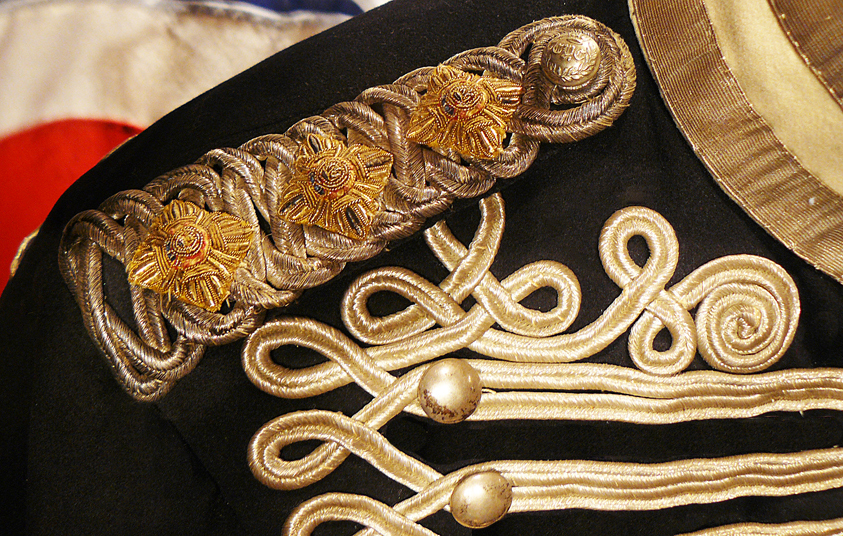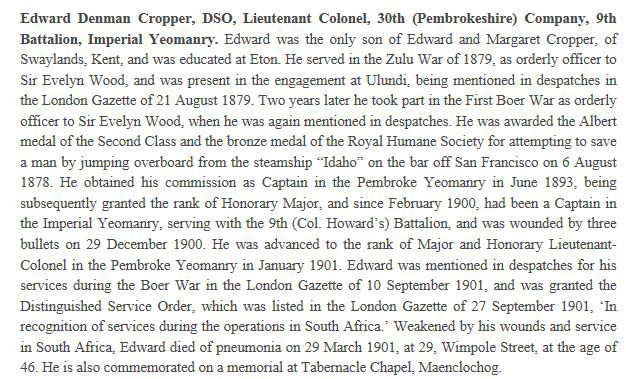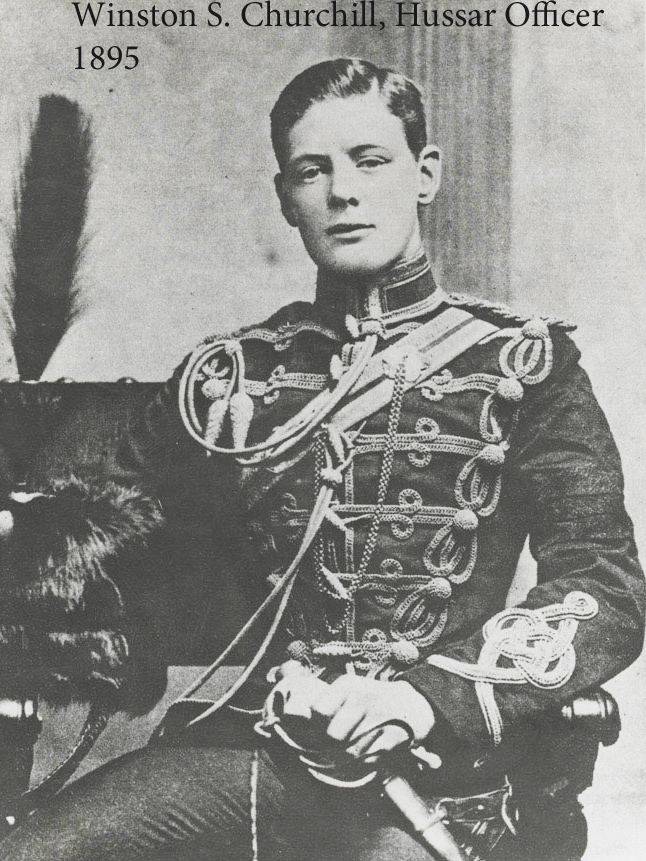A Fabulous Quality & Simply Beautiful Original Victorian Uniform Dolman Tunic of a Captain of the Pembrokeshire Hussars. An Hussar Regiment That Fought With Distinction In The Boer War.
blue cloth with white facings, silver bullion lace and braid trim including pointed ornamental cuffs, Austrian knot devices to back, 17 loops, with plain silver plated buttons to chest, shoulder cords with regimental buttons and 3 embroidered rank stars, white silk lining, pair matching overalls with double silver lace stripe. Good Condition, the lace generally bright overall. The officer who wore this superb uniform served alongside Col Cropper as a fellow Captain of the Pembrokeshire Hussars. As we know not this uniform's officer's name we show with the gallery the details of Col. Croppers distinguished career in the Zulu War and both Boer Wars. Hussar refers to a number of types of light cavalry. This type of cavalry first appeared in the Hungarian army of King Matthias Corvinus. The title and distinctive dress of these horsemen was subsequently widely adopted by light cavalry regiments in European and other armies. The hussars played a prominent role as cavalry in the Napoleonic Wars (1796-1815). As light cavalrymen mounted on fast horses, they would be used to fight skirmish battles and for scouting. Most of the great European powers raised hussar regiments. The armies of France, Austria, Prussia, and Russia had included hussar regiments since the mid-18th century. In the case of Britain, four light dragoon regiments were converted to hussars in 1806-1807.
Hussars were notoriously impetuous, and Napoleon was quoted as stating that he would be surprised for a hussar to live beyond the age of 30, due to their tendency to become reckless in battle, exposing their weaknesses in frontal assaults. The hussars of Napoleon created the tradition of sabrage, the opening of a champagne bottle with a sabre. Moustaches were universally worn by Napoleonic-era hussars; the British hussars were the only moustachioed troops in the British Army leading to their being taunted as being "foreigners", at times.
The French hussar of the Napoleonic period was armed with a brass-hilted sabre, a carbine and sometimes with a brace of pistols, although these were often unavailable. The British hussar was armed with, in addition to his firearms, the 1796-pattern light-cavalry sabre. British hussars also introduced the sabretache (a leather pouch hung from the swordbelt) to the British Army.
An extract from Chapter IX of the Historical Records of the Pembroke Yeomanry
The Pembrokeshire Hussars Yeomen, with the other 3 companies of the Welsh Yeomanry Battalion reached Cape Town on the 6th April, 1900, and were sent to Maitland camp, joining some 3,000 other yeomen, waiting their turn to go to the front. Stellenbosh and Wellington were the next places visited, and after some days of useful drilling the Pembrokeshire Yeomanry were ordered to join the Army at Bloemfontem.
On May 16th the Pembrokeshire and the two Montgomeryshire Companies of the Battalion, some 300 strong moved out to the North-west on a patrolling expedition, and after a week of this returned to Bloemfontein in time for the Queen's birthday parade. The Pembrokeshires. were given the place of honour in the van, and their smart appearance and soldier-like bearing, to quote his words, so pleased General Pretyman that he subsequently had the Yeomanry ranked past him in single file.
On May 27th the Pembrokeshire Squadron was ordered to Smithfield, Orange River Colony, Nos. 2 and 4 Troops being shortly afterwards sent to Rouxville, a small township nearer the Basuto Border, Nos. 1 and 3 Troops remaining at Smithfield under Major Cropper.
Leaving No. 1 Troop behind at Smithfield, under Captain Richardson the remaining three Troops of the Pembrokeshires on July 29th started on a three weeks' "trek," but nothing happened of interest, and after passing through Wepener and Dewetsdorp the company once more found itself at Bloemfontein.
On August 21st the company left by train for Ventersburg Weg, and with one of the Montgomeryshire Yeomanry Companies, and the Denbighshire Hussars formed part of Colonel White's column. On the 24th the advanced scouts of the column were in touch with the enemy, and next day the Pembrokeshire Yeomen exchanged their first shots with the Boers.
The Pembrokeshire Yeomanry, under Major Cropper, were forming the rearguard of the column which was moving back to Ventersburg, and had dispatched a troop under Lieutenants Jones and Blunt, to burn a farm from which the column had been fired upon.
The attacking troop, however, met with a hot reception, and Lieutenant Jones, whose horse was shot, had a narrow escape, and would have been captured but for the brave conduct of Trooper Atkinson, and Farrier Sergeant Williams, of Lampeter, who rode back to their officer's assistance.
Sergeant Williams, in his gallant act, was killed, and was buried in Ventersburg Cemetery, with the following epitaph on the little cross that marks his grave “Died whilst gallantly attempting to rescue his officer." Trooper Atkinson was recommended for the coveted Victoria Cross, but was only awarded the Distinguished Conduct Medal.
As the Boer Commando, against which Colonel J White's Column was operating had managed to escape, the Yeomanry were entrained for Winburg, and after a reconnaissance had been made against Oliver's Commando in that neighbourhood the Pembrokeshire men were moved to Bloemfontein.
Next the Pembrokes were hurriedly moved to the rescue of Lady brand, White's column being attached to General Bruce-Hamilton's Brigade. After some sharp short skirmishes Ladybrand, with its plucky little garrison of the Royal Wiltshire Yeomanry, was relieved.
One section of the Pembrokes was nearly cut off, and Trooper Atkinson had his horse shot, and was only saved by the gallantry of Sergeant Millett, who brought him out on his horse, covered by the rifles of a few Pembroke Yeomen.
Major Cropper's men assisted in driving a Boer Commando into the hands of General Hunter, and after another attempt to corner a Commando at Doornberg the Pembrokes were engaged in the Bethulie district assisting in re- organising and provisioning the neighbouring towns.
Meanwhile the Troop of the Pembrokeshire Yeomanry left under Captain Ernald Richardson at Rouxville had not been left idle and had been on duty garrisoning Fauresmith, Jagersfontein, and Pitensburg, three towns in a hotbed of Boerdom. At Fauresmith with two companies of HighlandIanders and Lovat's Yeomanry Scouts they were practically in a state of siege for two months. Hertzog's Commando joining the besieging force and here Trooper Stanley Thomas, of the company was killed, and another trooper (Greatorex) finding, on returning from picket duty, that he had left his bandolier outside, coolly clambered over the earthworks to get it. He, of course, drew the enemy's fire on him, and was badly hit.
Trooper Francis of the company made a famous ride with despatches from Fauresmith to Jagersfontein, and after being fired on by both friend and foe delivered his despatches and was rewarded with the rank of Corporal and the Distinguished Service Medal.
Captain Richardson's Troop, after Fauresmith was relieved, saw some active service with the columns in Cape Colony, and lost one or two wounded. The troop forming part of Colonel Hubert's column, and after several fights against Kritzerger eventually joined their squadron.
Major Cropper's three troops now took part in the relief of Phillipolis, and marched 60 miles in 24 hours - the Pembroke men out-distancing the other units of Colonel White's columns, and after rescuing the score of Nesbitt's Horse, who for a fortnight had held out against 600 men, repaired to Springfontein.
Reinforced by a squadron of the London Rough Riders, Colonel White's column moved out from Springfontein to clear the Boers from the line between and Bloemfontein. Three miles out from the town the Rough Riders, who were acting as scouts, were surprised in a narrow nek, and lost one killed and three wounded.
But the Pembrokes and some guns came to the rescue, and the dashing leadership of Major Cropper in the subsequent pursuit, earned the Pembrokeshire Yeomanry the commendation of their Column Commander.
In the early part of November, 1900 the Squadron, still with Colonel White's Column, were operating to the West of the Free State Capital, and had several' hot engagements with Hertzog and Brandt Commandoes, at one of which, with the 16th Lancers, near Aasvogel Kop the Pembroke men specially distinguished themselves.
News was now received that the Boer leader Haasbroek, who was marching down country to join De Wet, was expected to cross the Modder River between the Column and Bloemfontein. A hurried march brought the Column within touch of the Boers just after they had crossed the river, and after a hot fight the Commando was driven back, but not without heavy losses on both sides. The Pembroke Squadron dashing gallantly on this occasion was once more mentioned in despatches.
The Squadron now took part in the big Christmas drive of De Wet, who had close on 4,000 Boers under his command and despite the almost 4,000 Boers under his command and despite the almost perfect trap, De Wet and his men broke through the cordon.
But the chase was not given up, and the British Troops came on his rearguard, and after a hand to hand fight, in which the regular cavalry and Yeomanry specially distinguished themselves, darkness came and stopped the pursuit. The Boers lost 8 killed 33 wounded and 18 prisoners, and a large number of horses.
General Knox, the British Commander, followed De Wet right up the East side of the Orange Free State, occasionally hastening his movements with a few shells or a sharp skirmish. In all these latter fights the Pembroke Yeomen bore their part.
At Hammonia near Ficksburg a very stiff fight with the Boers took place. The enemy had surprised the Denbighshire Hussars, who were acting as an advance guard, and the Pembroke and Montgomeryshire Yeomanry were ordered up, and eventually drove the Boers off, clearing the ridge with their hot and sharp fire.
The company still in pursuit of De Wet spent its Christmas Day at Kaffir Kop, but hardly had the Christmas dinner been finished than scouts rode in to say that De Wet had again given the Troops the slip. On January 1st, 1901, the Pembrokes were again hot on De Wet's trail, and on the 3rd. at Kaffir Kop, the Pembrokes with the rest of the Welsh Yeomanry were ordered to make a flanking movement to dislodge the Boers, who had taken up some strong positions.
The Pembrokeshire Yeomanry some 30 strong, attempted to rush the enemy, who were lining a rocky kopje fronted by a deep donga. Down the slope which led to the enemy's position went the small troop, and as they galloped the fire grew fiercer. The few" Boers who were supposed to be there numbered apparently close on 500. Some twenty yards in front of his men was Major Cropper, till stopped by a precipitous descent of some 20 feet. No horseman could ride down it, and to dismount was to count certain death. Slowly Major Cropper, who had been twice hit while so gallantly leading his men, wheeled his horse round and pointed with his hand for them to retire, which was at once done. When Major Cropper reached the ridge he fell off his horse into the arms of Colonel Forbes, al- most senseless, gasping “Couldn't do it, sir."
He had been hit three times and had ridden grasping his saddle with both hands. The gallant Major was at once invalided home, and a few months afterwards died of his wounds. No one else was hit in this death ride, although several had their clothes riddled with bullets, and their horses wounded.
The remnant of the Pembrokes were now under the charge of Lieutenants Jones and Blunt.
The other Troop under Captain Richardson had by now rejoined the company, and after some hot work after De Wet in wild Karoo desert, found themselves in March, 1901, engaged in clearing the country south of Bloemfontein.
Then came more clearing of the rebel farms, and finally the new 30th (Pembrokeshire) Company of Yeomanry arrived to relieve them.
A few more weeks were spent with Colonel White's Column, and then orders were issued for the old company to proceed to Worcester, where remnants of the original 9th Battalion were to mobilise.
Another misfortune befell the Company ere its departure for home. Sergeant Major Prothero, after successfully resisting an attack of enteric fever, fell a victim to pneumonia, to the great regret of all ranks.
At last the company embarked for home, and on their arrival at Tenby were accorded a splendid reception, and the members of the Squadron later had the honour of receiving the medals from the King on that memorable day when His Majesty decorated some thousands of his Imperial Yeomen in London.
Code: 22420
2950.00 GBP






